check engine light Lexus CT200h 2013 Owner's Manual (in English)
[x] Cancel search | Manufacturer: LEXUS, Model Year: 2013, Model line: CT200h, Model: Lexus CT200h 2013Pages: 688
Page 7 of 688

7
1
8 7
6
5
4
3
2
CT200h_OM_OM76102E_(EE)
9
6-4. Other interior features
Other interior features ....... 473
• Sun visors...................... 473
• Vanity mirrors ............... 473
• Clock ............................. 474
• Power outlet .................. 475
• Assist grips.................... 477
7-1. Maintenance and care
Cleaning and protecting the
vehicle exterior.................480
Cleaning and protecting the
vehicle interior.................484
7-2. Maintenance
Maintenance require-
ments...............................4877-3. Do-it-yourself maintenance
Do-it-yourself service precau-
tions..................................490
Hood .................................. 492
Positioning a floor jack ..... 494
Engine compartment ......... 495
12-volt battery ................... 504
Tires................................... 510
Tire inflation pressure ....... 523
Wheels............................... 525
Air conditioning filter ....... 527
Electronic key battery ....... 530
Checking and replacing
fuses.................................534
Light bulbs ........................ 538
8-1. Essential information
Emergency flashers ........... 560
If your vehicle has to be stopped
in an emergency...............561
7Maintenance and care
8When trouble arises
Page 17 of 688
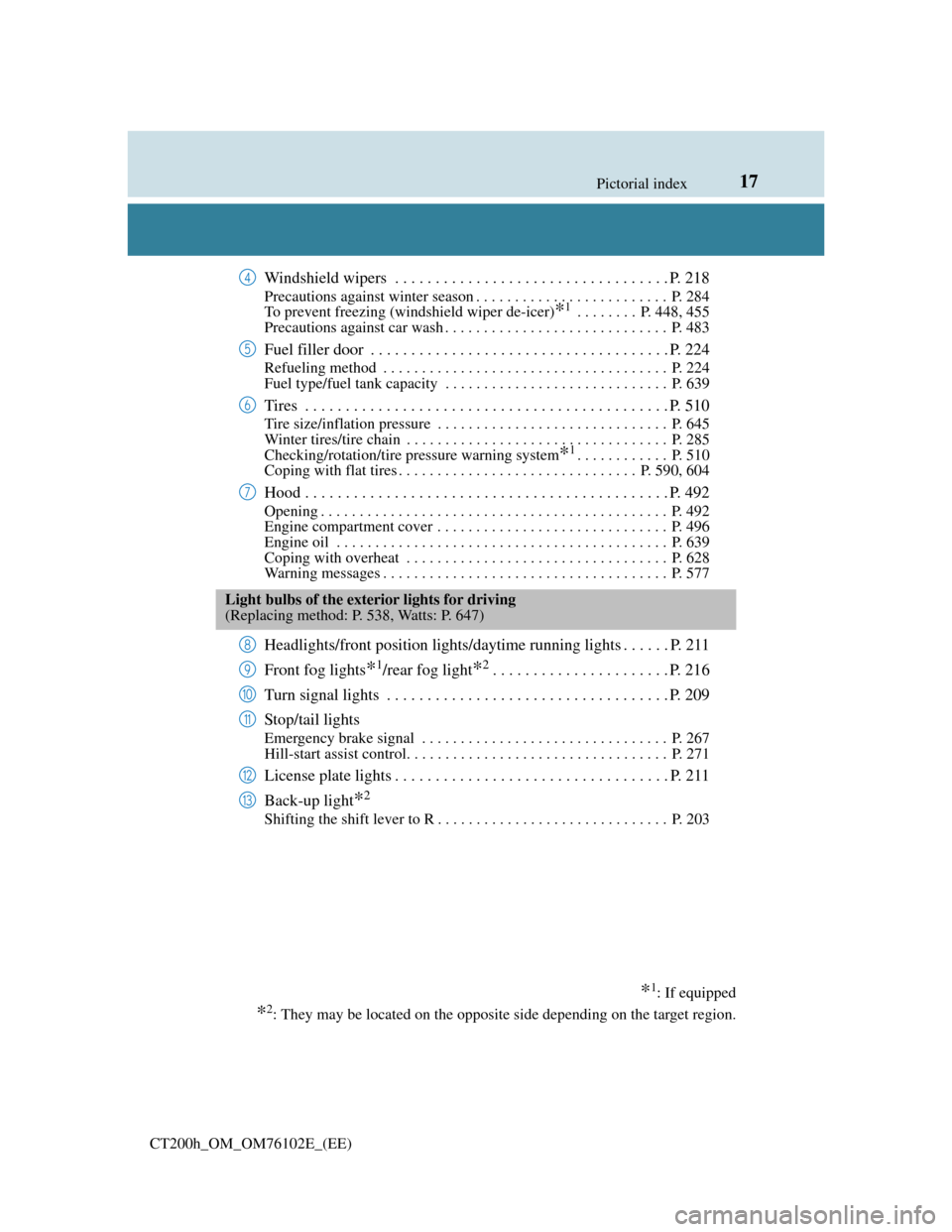
17Pictorial index
CT200h_OM_OM76102E_(EE)
Windshield wipers . . . . . . . . . . . . . . . . . . . . . . . . . . . . . . . . . . P. 218
Precautions against winter season . . . . . . . . . . . . . . . . . . . . . . . . . P. 284
To prevent freezing (windshield wiper de-icer)
*1 . . . . . . . . P. 448, 455
Precautions against car wash . . . . . . . . . . . . . . . . . . . . . . . . . . . . . P. 483
Fuel filler door . . . . . . . . . . . . . . . . . . . . . . . . . . . . . . . . . . . . . P. 224
Refueling method . . . . . . . . . . . . . . . . . . . . . . . . . . . . . . . . . . . . . P. 224
Fuel type/fuel tank capacity . . . . . . . . . . . . . . . . . . . . . . . . . . . . . P. 639
Tires . . . . . . . . . . . . . . . . . . . . . . . . . . . . . . . . . . . . . . . . . . . . . P. 510
Tire size/inflation pressure . . . . . . . . . . . . . . . . . . . . . . . . . . . . . . P. 645
Winter tires/tire chain . . . . . . . . . . . . . . . . . . . . . . . . . . . . . . . . . . P. 285
Checking/rotation/tire pressure warning system
*1. . . . . . . . . . . . P. 510
Coping with flat tires . . . . . . . . . . . . . . . . . . . . . . . . . . . . . . . P. 590, 604
Hood . . . . . . . . . . . . . . . . . . . . . . . . . . . . . . . . . . . . . . . . . . . . . P. 492
Opening . . . . . . . . . . . . . . . . . . . . . . . . . . . . . . . . . . . . . . . . . . . . . P. 492
Engine compartment cover . . . . . . . . . . . . . . . . . . . . . . . . . . . . . . P. 496
Engine oil . . . . . . . . . . . . . . . . . . . . . . . . . . . . . . . . . . . . . . . . . . . P. 639
Coping with overheat . . . . . . . . . . . . . . . . . . . . . . . . . . . . . . . . . . P. 628
Warning messages . . . . . . . . . . . . . . . . . . . . . . . . . . . . . . . . . . . . . P. 577
Headlights/front position lights/daytime running lights . . . . . . P. 211
Front fog lights
*1/rear fog light*2. . . . . . . . . . . . . . . . . . . . . . P. 216
Turn signal lights . . . . . . . . . . . . . . . . . . . . . . . . . . . . . . . . . . . P. 209
Stop/tail lights
Emergency brake signal . . . . . . . . . . . . . . . . . . . . . . . . . . . . . . . . P. 267
Hill-start assist control. . . . . . . . . . . . . . . . . . . . . . . . . . . . . . . . . . P. 271
License plate lights . . . . . . . . . . . . . . . . . . . . . . . . . . . . . . . . . . P. 211
Back-up light
*2
Shifting the shift lever to R . . . . . . . . . . . . . . . . . . . . . . . . . . . . . . P. 203
4
5
6
7
Light bulbs of the exterior lights for driving
(Replacing method: P. 538, Watts: P. 647)
*1: If equipped
*2: They may be located on the opposite side depending on the target region.
8
9
10
11
12
13
Page 108 of 688
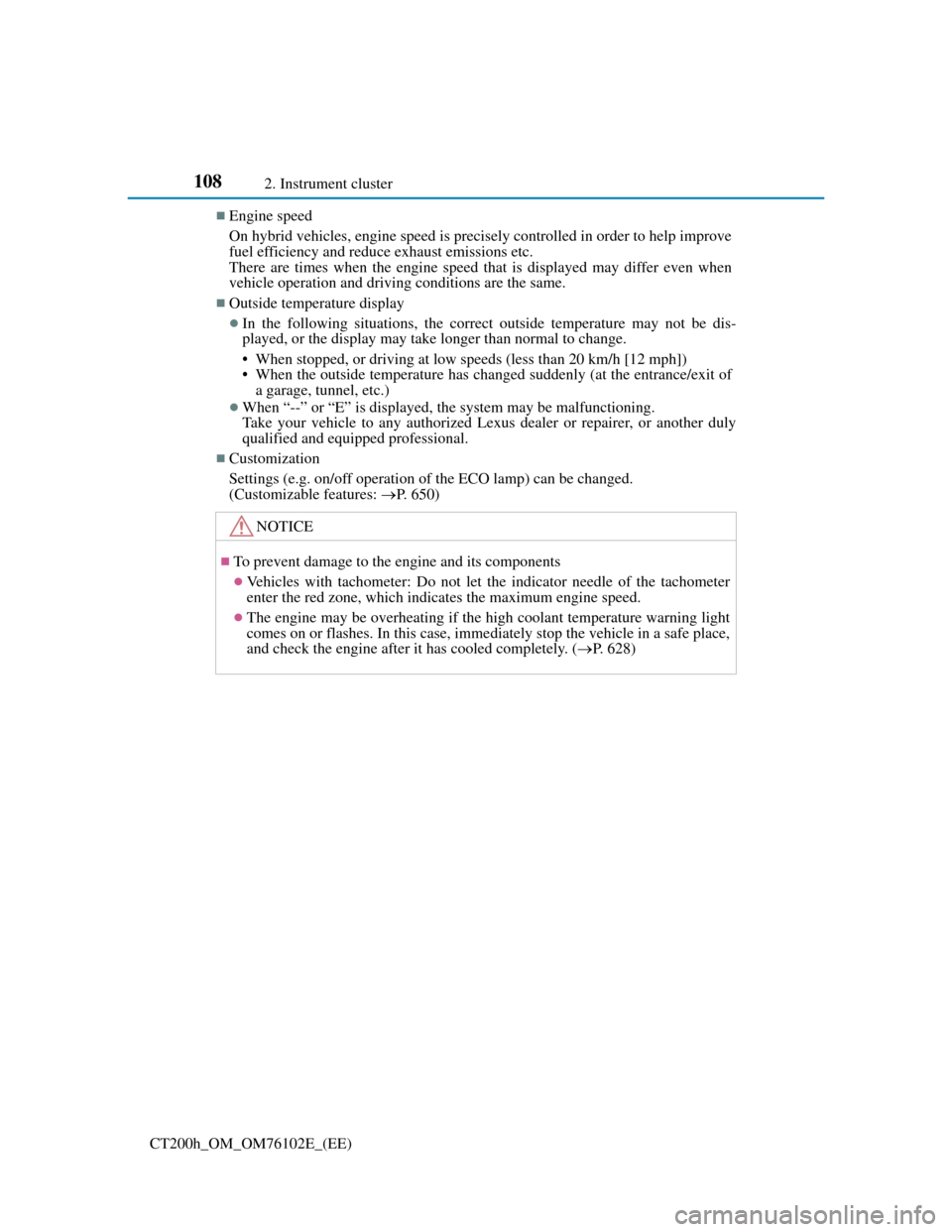
1082. Instrument cluster
CT200h_OM_OM76102E_(EE)
Engine speed
On hybrid vehicles, engine speed is precisely controlled in order to help improve
fuel efficiency and reduce exhaust emissions etc.
There are times when the engine speed that is displayed may differ even when
vehicle operation and driving conditions are the same.
Outside temperature display
In the following situations, the correct outside temperature may not be dis-
played, or the display may take longer than normal to change.
• When stopped, or driving at low speeds (less than 20 km/h [12 mph])
• When the outside temperature has changed suddenly (at the entrance/exit of
a garage, tunnel, etc.)
When “--” or “E” is displayed, the system may be malfunctioning.
Take your vehicle to any authorized Lexus dealer or repairer, or another duly
qualified and equipped professional.
Customization
Settings (e.g. on/off operation of the ECO lamp) can be changed.
(Customizable features: P. 650)
NOTICE
To prevent damage to the engine and its components
Vehicles with tachometer: Do not let the indicator needle of the tachometer
enter the red zone, which indicates the maximum engine speed.
The engine may be overheating if the high coolant temperature warning light
comes on or flashes. In this case, immediately stop the vehicle in a safe place,
and check the engine after it has cooled completely. (P. 628)
Page 188 of 688

1884-1. Before driving
CT200h_OM_OM76102E_(EE)
WA R N I N G
Observe the following precautions.
Failure to do so may result in death or serious injury.
When starting the vehicle
Always keep your foot on the brake pedal while stopped with the “READY”
indicator is illuminated. This prevents the vehicle from creeping.
When driving the vehicle
Do not drive if you are unfamiliar with the location of the brake and accelera-
tor pedals to avoid depressing the wrong pedal.
• Accidentally depressing the accelerator pedal instead of the brake pedal
will result in sudden acceleration that may lead to an accident.
• When backing up, you may twist your body around, leading to a difficulty
in operating the pedals. Make sure to operate the pedals properly.
• Make sure to keep a correct driving posture even when moving the vehicle
only slightly. This allows you to depress the brake and accelerator pedals
properly.
• Depress the brake pedal using your right foot. Depressing the brake pedal
using your left foot may delay response in an emergency, resulting in an
accident.
The driver should pay extra attention to pedestrians when the vehicle is pow-
ered only by the electric motor (traction motor). As there is no engine noise,
the pedestrians may misjudge the vehicle’s movement.
Do not drive the vehicle over or stop the vehicle near flammable materials.
The exhaust system and exhaust gases can be extremely hot. These hot parts
may cause a fire if there is any flammable material nearby.
During normal driving, do not turn off the hybrid system. Turning the hybrid
system off while driving will not cause loss of steering or braking control,
however, power assist to the steering will be lost. This will make it more diffi-
cult to steer smoothly, so you should pull over and stop the vehicle as soon as
it is safe to do so. In the event of an emergency, such as if it becomes impossi-
ble to stop the vehicle in the normal way: P. 5 6 1
Use engine braking (shift position B instead of shift position D) to maintain a
safe speed when driving down a steep hill.
Using the brakes continuously may cause the brakes to overheat and lose
effectiveness. (P. 204)
Do not adjust the positions of the steering wheel, the seat, or the inside or out-
side rear view mirrors while driving.
Doing so may result in a loss of vehicle control.
Always check that all passengers’ arms, heads or other parts of their body are
not outside the vehicle.
Page 196 of 688
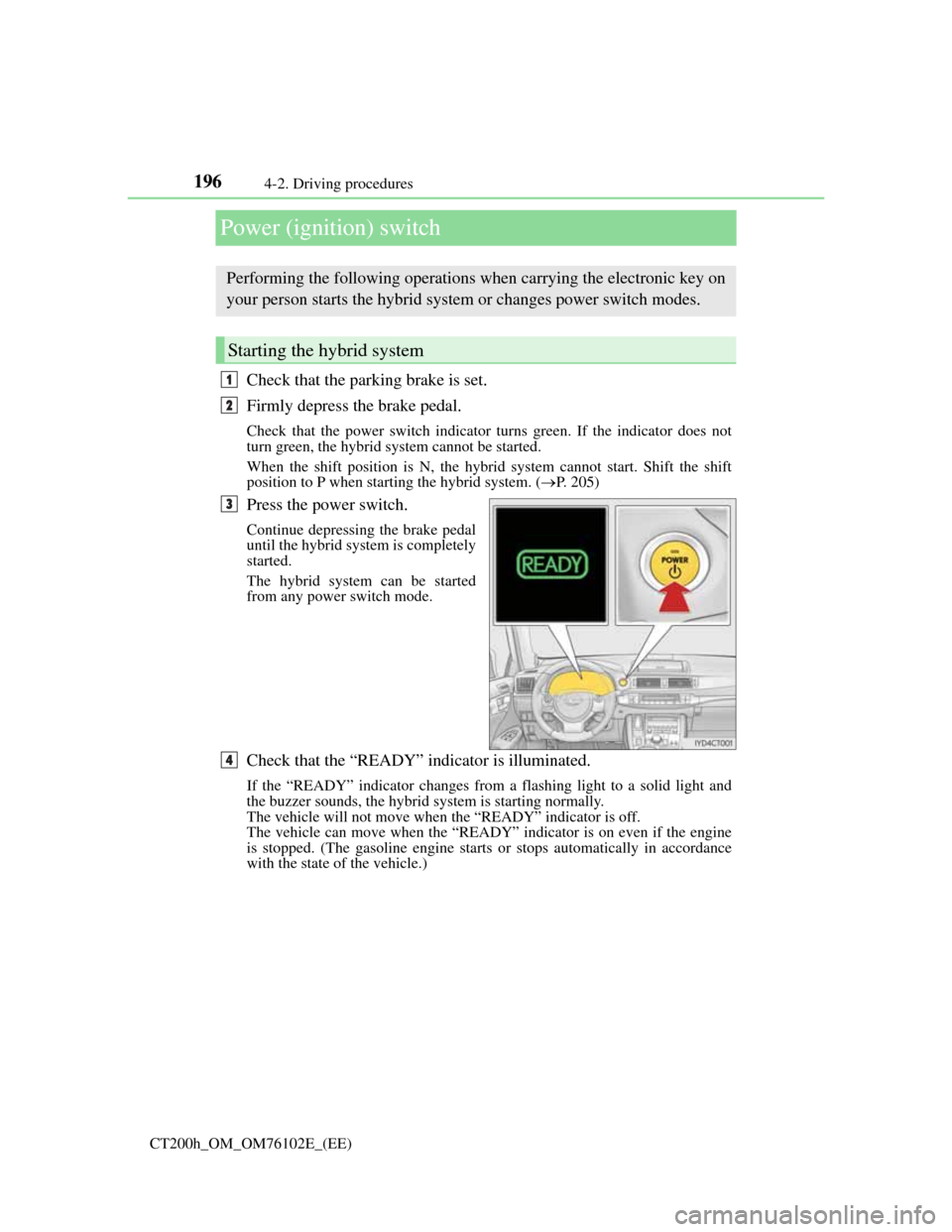
1964-2. Driving procedures
CT200h_OM_OM76102E_(EE)
Power (ignition) switch
Check that the parking brake is set.
Firmly depress the brake pedal.
Check that the power switch indicator turns green. If the indicator does not
turn green, the hybrid system cannot be started.
When the shift position is N, the hybrid system cannot start. Shift the shift
position to P when starting the hybrid system. (P. 205)
Press the power switch.
Continue depressing the brake pedal
until the hybrid system is completely
started.
The hybrid system can be started
from any power switch mode.
Check that the “READY” indicator is illuminated.
If the “READY” indicator changes from a flashing light to a solid light and
the buzzer sounds, the hybrid system is starting normally.
The vehicle will not move when the “READY” indicator is off.
The vehicle can move when the “READY” indicator is on even if the engine
is stopped. (The gasoline engine starts or stops automatically in accordance
with the state of the vehicle.)
Performing the following operations when carrying the electronic key on
your person starts the hybrid system or changes power switch modes.
Starting the hybrid system
1
2
3
4
Page 284 of 688

2824-6. Driving tips
CT200h_OM_OM76102E_(EE)
Delays
Repeated acceleration and deceleration, as well as long waits at traffic
lights, will lead to bad fuel economy. Check traffic reports before leav-
ing and avoid delays as much as possible. When driving in a traffic
jam, gently release the brake pedal to allow the vehicle to move for-
ward slightly while avoiding overuse of the accelerator pedal. Doing so
can help control excessive gasoline consumption.
Highway driving
Control and maintain the vehicle at a constant speed. Before stopping
at a toll booth or similar, allow plenty of time to release the accelerator
and gently apply the brakes. A greater amount of electrical energy can
be regenerated when slowing down.
Air conditioning
Use the air conditioning only when necessary. Doing so can help
reduce excessive gasoline consumption.
In summer: When the ambient temperature is high, use the recirculated
air mode. Doing so will help to reduce the burden on the air condition-
ing system and reduce fuel consumption as well.
In winter: Because the gasoline engine will not automatically cut out
until it and the interior of the vehicle are warm, it will consume fuel.
Fuel consumption can be improved by avoiding overuse of the heater.
Checking tire inflation pressure
Make sure to check the tire inflation pressure frequently. Improper tire
inflation pressure can cause poor fuel economy.
Also, as snow tires can cause large amounts of friction, their use on dry
roads can lead to poor fuel economy. Use tires that are appropriate for
the season.
Page 286 of 688
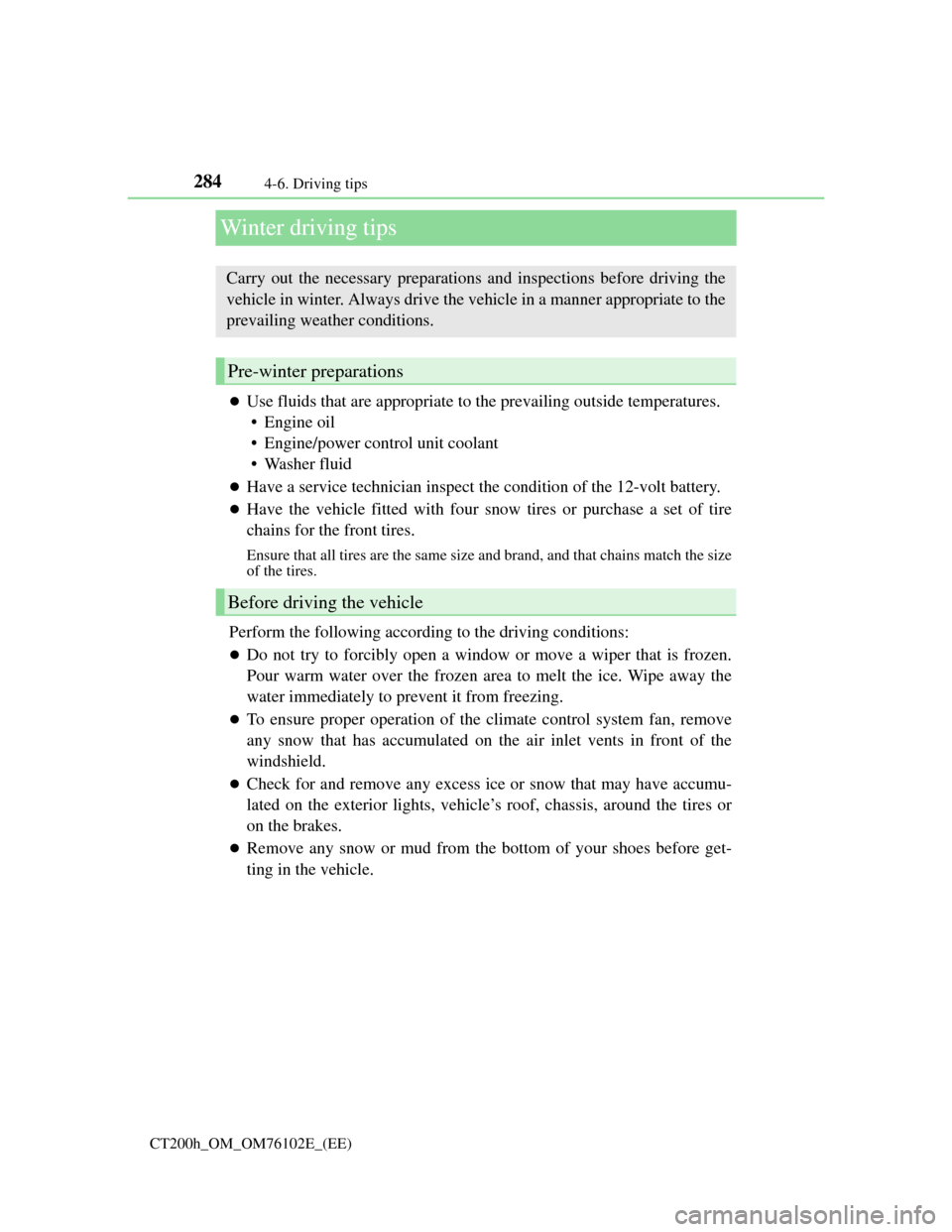
2844-6. Driving tips
CT200h_OM_OM76102E_(EE)
Winter driving tips
Use fluids that are appropriate to the prevailing outside temperatures.
•Engine oil
• Engine/power control unit coolant
•Washer fluid
Have a service technician inspect the condition of the 12-volt battery.
Have the vehicle fitted with four snow tires or purchase a set of tire
chains for the front tires.
Ensure that all tires are the same size and brand, and that chains match the size
of the tires.
Perform the following according to the driving conditions:
Do not try to forcibly open a window or move a wiper that is frozen.
Pour warm water over the frozen area to melt the ice. Wipe away the
water immediately to prevent it from freezing.
To ensure proper operation of the climate control system fan, remove
any snow that has accumulated on the air inlet vents in front of the
windshield.
Check for and remove any excess ice or snow that may have accumu-
lated on the exterior lights, vehicle’s roof, chassis, around the tires or
on the brakes.
Remove any snow or mud from the bottom of your shoes before get-
ting in the vehicle.
Carry out the necessary preparations and inspections before driving the
vehicle in winter. Always drive the vehicle in a manner appropriate to the
prevailing weather conditions.
Pre-winter preparations
Before driving the vehicle
Page 483 of 688

479
7Maintenance and care
CT200h_OM_OM76102E_(EE)
7-1. Maintenance and care
Cleaning and protecting the
vehicle exterior ............... 480
Cleaning and protecting the
vehicle interior ................ 484
7-2. Maintenance
Maintenance
requirements ................... 487
7-3. Do-it-yourself maintenance
Do-it-yourself service
precautions...................... 490
Hood ................................. 492
Positioning a floor jack ..... 494
Engine compartment ......... 495
12-volt battery................... 504
Tires .................................. 510
Tire inflation pressure ....... 523
Wheels .............................. 525
Air conditioning filter ....... 527
Electronic key battery ....... 530
Checking and replacing
fuses ................................ 534
Light bulbs ........................ 538
Page 542 of 688
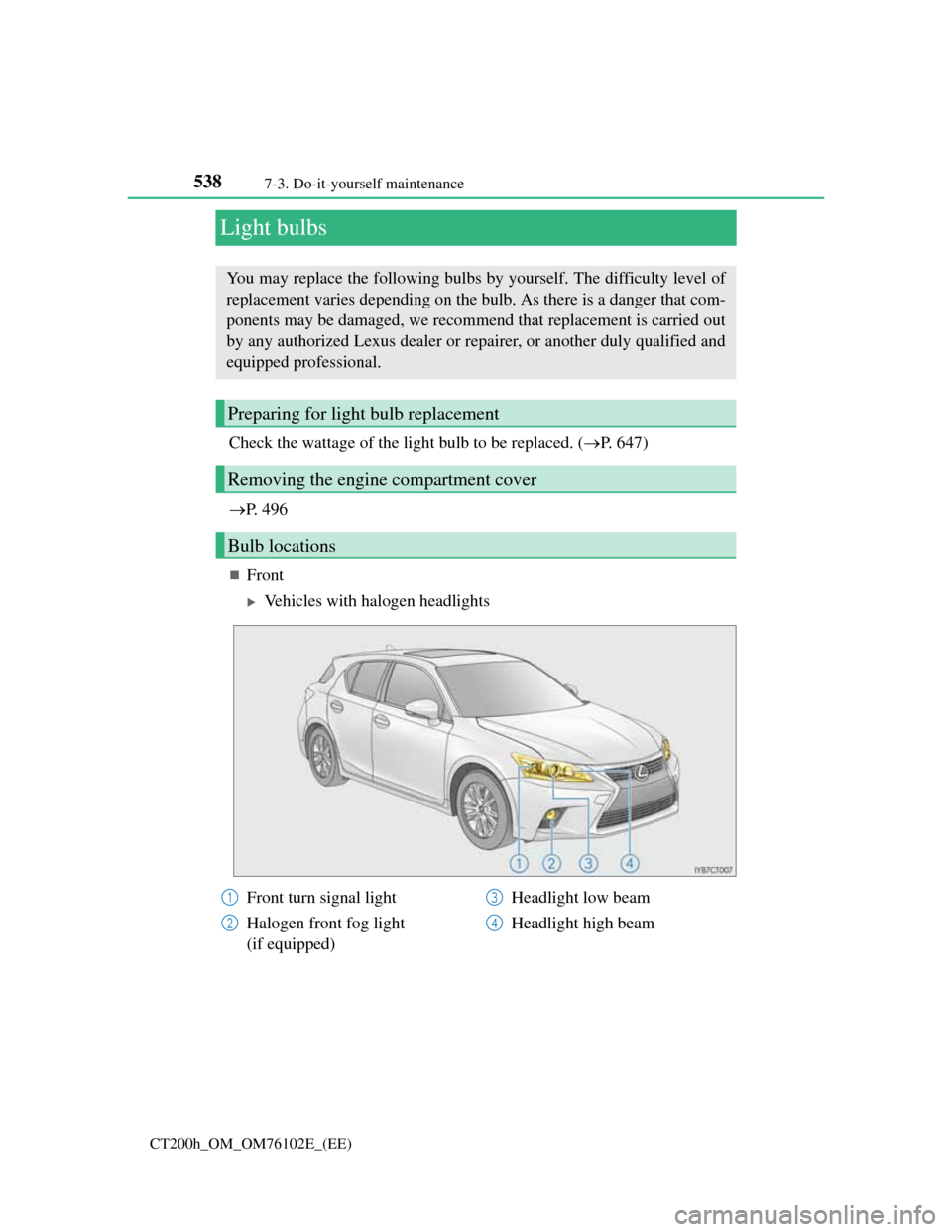
5387-3. Do-it-yourself maintenance
CT200h_OM_OM76102E_(EE)
Light bulbs
Check the wattage of the light bulb to be replaced. (P. 647)
P. 4 9 6
Front
Vehicles with halogen headlights
You may replace the following bulbs by yourself. The difficulty level of
replacement varies depending on the bulb. As there is a danger that com-
ponents may be damaged, we recommend that replacement is carried out
by any authorized Lexus dealer or repairer, or another duly qualified and
equipped professional.
Preparing for light bulb replacement
Removing the engine compartment cover
Bulb locations
Front turn signal light
Halogen front fog light
(if equipped)Headlight low beam
Headlight high beam1
2
3
4
Page 574 of 688
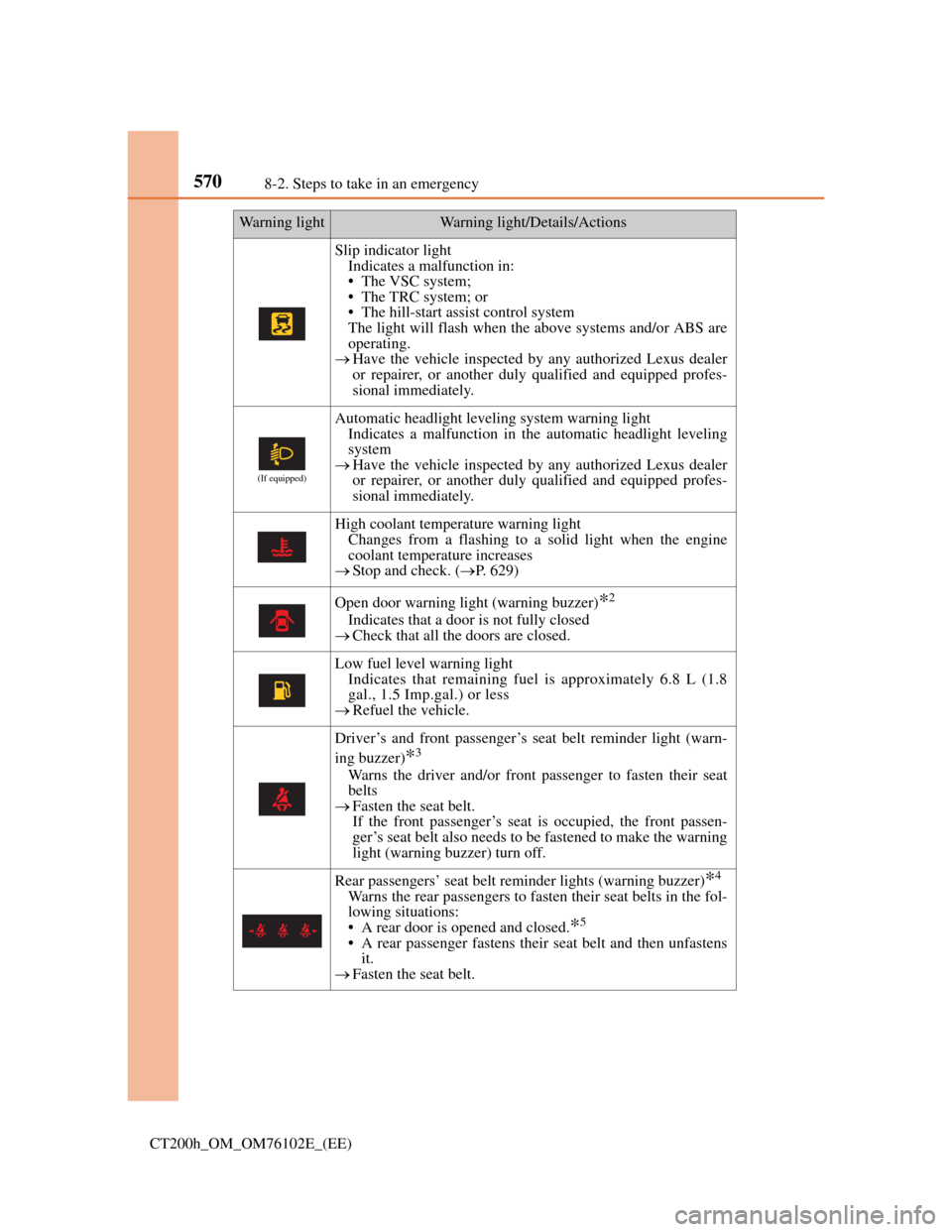
5708-2. Steps to take in an emergency
CT200h_OM_OM76102E_(EE)
Slip indicator light
Indicates a malfunction in:
• The VSC system;
• The TRC system; or
• The hill-start assist control system
The light will flash when the above systems and/or ABS are
operating.
Have the vehicle inspected by any authorized Lexus dealer
or repairer, or another duly qualified and equipped profes-
sional immediately.
(If equipped)
Automatic headlight leveling system warning light
Indicates a malfunction in the automatic headlight leveling
system
Have the vehicle inspected by any authorized Lexus dealer
or repairer, or another duly qualified and equipped profes-
sional immediately.
High coolant temperature warning light
Changes from a flashing to a solid light when the engine
coolant temperature increases
Stop and check. (P. 629)
Open door warning light (warning buzzer)*2
Indicates that a door is not fully closed
Check that all the doors are closed.
Low fuel level warning light
Indicates that remaining fuel is approximately 6.8 L (1.8
gal., 1.5 Imp.gal.) or less
Refuel the vehicle.
Driver’s and front passenger’s seat belt reminder light (warn-
ing buzzer)
*3
Warns the driver and/or front passenger to fasten their seat
belts
Fasten the seat belt.
If the front passenger’s seat is occupied, the front passen-
ger’s seat belt also needs to be fastened to make the warning
light (warning buzzer) turn off.
Rear passengers’ seat belt reminder lights (warning buzzer)*4
Warns the rear passengers to fasten their seat belts in the fol-
lowing situations:
• A rear door is opened and closed.
*5
• A rear passenger fastens their seat belt and then unfastens
it.
Fasten the seat belt.
Warning lightWarning light/Details/Actions